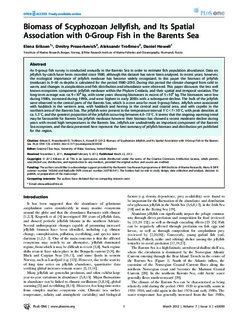Biomass of Scyphozoan Jellyfish, and Its Spatial Association with 0-Group Fish in the Barents Sea
Journal article, Peer reviewed
Permanent lenke
http://hdl.handle.net/11250/109240Utgivelsesdato
2012-03-22Metadata
Vis full innførselSamlinger
- Articles [3012]
Originalversjon
http://dx.doi.org/10.1371/journal.pone.0033050Sammendrag
An 0-group fish survey is conducted annually in the Barents Sea in order to estimate fish population abundance. Data on
jellyfish by-catch have been recorded since 1980, although this dataset has never been analysed. In recent years, however,
the ecological importance of jellyfish medusae has become widely recognized. In this paper the biomass of jellyfish
(medusae) in 0–60 m depths is calculated for the period 1980–2010. During this period the climate changed from cold to
warm, and changes in zooplankton and fish distribution and abundance were observed. This paper discusses the less well
known ecosystem component; jellyfish medusae within the Phylum Cnidaria, and their spatial and temporal variation. The
long term average was ca. 9x10^8 kg, with some years showing biomasses in excess of 5x10^9 kg. The biomasses were low
during 1980s, increased during 1990s, and were highest in early 2000s with a subsequent decline. The bulk of the jellyfish
were observed in the central parts of the Barents Sea, which is a core area for most 0-group fishes. Jellyfish were associated
with haddock in the western area, with haddock and herring in the central and coastal area, and with capelin in the
northern area of the Barents Sea. The jellyfish were present in the temperature interval 1°C
